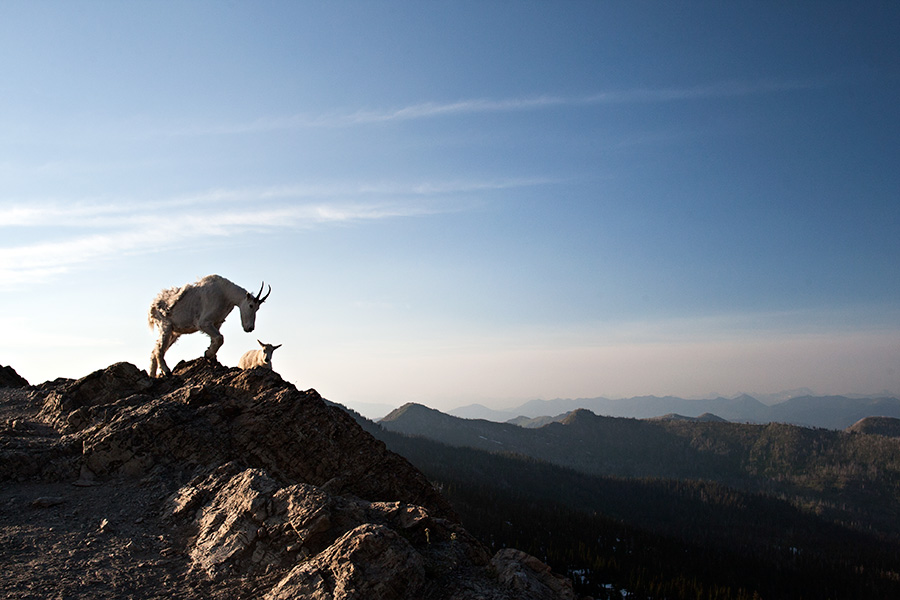Conservationists and biologists are seeking to understand, stem and reverse ongoing declines in one of Northwest Montana’s most iconic animals — the mountain goat — and to do so they’re looking into the past as well as the future.
A recent report by field biologists with Montana Fish, Wildlife and Parks examines the status of mountain goats in the Treasure State going back 60 years and surveying 18 FWP biologists who manage goats statewide.
Tough and resilient though they are, mountain goat populations have decreased in several of western Montana’s historic strongholds, according to the report, which demonstrate that mountain goat numbers in Northwest Montana are slow to rebound, particularly among populations in areas including the Cabinet Mountains, Scotchman Peaks, and Whitefish and Swan ranges, which once served as strongholds for the species.
An iconic native species in Montana, mountain goats are valued not only for hunting, but also for wildlife viewing and photography. Wildlife managers say there is strong public interest in establishing and maintaining mountain goats wherever suitable habitat exists.
Motorized recreation in their winter ranges is one stressor that could be driving goat populations away from prime forage areas, while avalanches, predation, treacherous habitat, hunting, and global climate change remain constant threats.
“There’s finally enough science to show that winter motorized use has an impact on goats,” said Amy Robinson, Northwest Montana field director for the Montana Wilderness Association. “And researchers in Glacier National Park are studying the impacts of climate change on goats in the park specifically, where goat populations seem to be doing better.”
Researchers in the park are preparing a three- to four-year monitoring study of goats to learn more about the impacts of climate change.
The high-alpine creatures are susceptible to climate change as the loss of glaciers and snowfields dries up water sources, while the rising treeline reduces foraging opportunities. Goats are specially adapted to thrive in snow-covered landscapes, reflected in their thick coats of white, which serve as camouflage against predators and insulation against the cold.
In the 1950s, mountain goats were considered abundant across Northwest Montana, with multiple populations spread out across the region, but logging and road construction displaced goats, putting them under increased hunting pressures.
Initially considered an unlimited resource, biologists thought the remoteness of mountain goat habitat would impede access and that hunting would never significantly impact the population. By the 1960s, however, timber harvests and associated logging roads pioneered routes into the backcountry, opening the way for hunters.
Beginning in 1960, biologists observed a dramatic decline in goat numbers in certain areas due to increased accessibility, and the first restrictions were placed on goat harvests. By 1972, all hunting districts in the region were being managed by a limited permit system.
“Unfortunately, it was too late for some goat herds,” according to Jessy Coltrane, a wildlife biologist with FWP.
Current goat hunting districts were established in 1986, and wildlife biologists have been reducing the number of licenses available ever since. Even with limited data available, FWP managers have determined that in order to reverse the trend, harvest quotas may need to be further reduced or eliminated in some hunting districts.
Despite reduced harvests, mountain goats in the region have not rebounded to historic levels, and most populations are described by local management biologists as declining.
“Currently, wildlife biologists in the region are faced with uncertainty concerning the future of native herds and a need for additional data to better ensure their persistence,” Coltrane wrote in an FWP newsletter summarizing the recent studies.
Complicating the status of mountain goats in Montana is the distribution of native and nonnative populations.
The western portion of the state supports native populations, while to the east additional populations were established by translocating goats into previously unoccupied territory.
A 2008 study by FWP estimated a statewide population of 2,719 mountain goats in Montana. Of that total, 1,517 animals were in introduced populations and 1,202 were in native populations. In 2016, Montana’s native goat population estimate was 1,159.
“The decline in mountain goat populations is alarming and deserves investigation by Montana Fish, Wildlife and Parks,” according to a 2008 report. “When goat populations decline, it appears they don’t recover.”
The aim of the most recent FWP study is to compile and synthesize mountain goat harvest and population information on a statewide scale over the past 60 years, with special attention paid to comparing and contrasting the dynamics of native and introduced populations.
